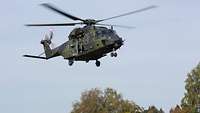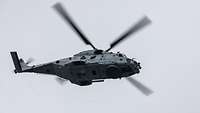NATONorth Atlantic Treaty Organization - Helicopter 90 (NH90)
NATONorth Atlantic Treaty Organization - Helicopter 90 (NH90)
NATONorth Atlantic Treaty Organization - Helicopter 90 (NH90)
The objective of the multinational NATONorth Atlantic Treaty Organization Helicopter (NHNATO-Helicopter) 90 project was to develop a helicopter family of the nine-to-eleven ton class for transport and navy operations. The development program was initiated by the four founding nations France, Italy, the Netherlands and Germany.
Starting from a common baseline helicopter, two basic versions were developed: a navy helicopter (NFHNato Frigate Helicopter NATONorth Atlantic Treaty Organization frigate helicopter) and a transport helicopter (TTHTactical Transport Helicopter tactical transport helicopter). Requirements of the participating nations deviating from the baseline helicopter are commissioned as national helicopter variants.
Operational Tasks
The German Army uses the NH90 mainly for tactical transport, search and rescue operations. In addition, it is possible to conduct maritime flights and self-deployments across large distances and to realize the roles of convoy protection/self-protection if the helicopter is equipped with the necessary equipment packages.
In 2013 and 2014, four NH90 were successfully employed as forward air medical evacuation helicopters in Afghanistan.
Since early 2017, the NH90 has also been used successfully in Mali.
The German Navy will primarily use the NH90 NTHNaval Transport Helicopter Sea Lion for the following tasks: tactical transport of personnel (including special forces and specialized forces) and material, sea surveillance, military and civilian search and rescue operations over sea, (medical) evacuation and boarding. The NTHNaval Transport Helicopter Sea Lion will operate over sea both from aboard the class 702 combat support ship and from ashore.
Program
The contractual partners involved in the NH90 program are the NAHEMA (NATONorth Atlantic Treaty Organization Helicopter Management Agency; International Program Office based in Aix-en-Provence, France) as the customer representing the participating program nations and the NHINATO Helicopters Industries Group (NATONorth Atlantic Treaty Organization Helicopter Industries; consortium of companies from the participating countries: Airbus Helicopters Deutschland (AHDAirbus Helicopters Deutschland), Airbus Helicopters S.A.S, AugustaWestland and Fokker) as the contractor. Germany’s work share in production is approximately 31%.
The first flight of the PT 1 prototype took place in December 1995; the last of a total number of five prototypes (PT 5, navy version) made its first flight in December 1999.
The program partners are procuring nationally adapted variants of the production helicopter. Originally, the German Armed Forces ordered 122 NH90 helicopters in the TTHTactical Transport Helicopter configuration as replacement for the UH-1D of the German Air Force and the German Army.
In the context of the restructuring of the Bundeswehr however, an amendment to the existing NH90 contract was signed by the NAHEMA on the basis of a “helicopter framework agreement” concluded between Germany and the contractor. This contract amendment resulted in a reduction of the purchase quantity to 82 NH90 TTHTactical Transport Helicopter helicopters earmarked exclusively for the German Army and the procurement of 18 NH90 NTHNaval Transport Helicopter Sea Lion helicopters as successor to the Mk41 Sea King helicopters as well as the agreement of an option to purchase another 22 NH90 TTHTactical Transport Helicopter helicopters.
Apart from the four remaining founding nations, Belgium was to join the NH90 program in subsequent years. As the so-called NHNATO-Helicopter 90 community of export nations, Sweden, Finland, Norway, Greece, Australia, New Zealand and Spain are cooperating closely with the founding nations during the in-service use phase. Furthermore, Oman and Greece are using the NH90 in their armed forces. At present, Qatar is another potential buyer.
Germany has so far taken delivery of several NHNATO-Helicopter 90 helicopters in various configurations. The delivery process of the NH90 TTHTactical Transport Helicopter variant, which started with the delivery of the first helicopter at the end of 2006, is expected to be completed by 2021.
The first NH90 NTHNaval Transport Helicopter Sea Lion was handed over to the Bundeswehr on 24 October 2019. Deliveries are planned to be completed by 2022.
Technical Data
The NH90 is driven by two turboshaft engines with mixed radial and axial compressor and a four-blade rotor and is equipped with fly-by-wire flight control.
It offers a high degree of habitability due to a low level of vibration, good noise attenuation and air-conditioning. One-pilot operation is possible under all operational conditions.
The NH90 is operational both during the day and at night under all weather conditions, even in the case of icing.
The high degree of reliability and availability of the helicopter is accompanied by an equally high degree of maintainability.
Special mention should also be made of the helicopter’s reduced vulnerability and detectability as well as its tremendous growth potential.
Helicopter dimensions
Specifications | Actual value |
|---|---|
Width | 4.65 m |
Height | 5.23 m |
Length | 19.60 m |
Rotor diameter | 16.30 m |
Cockpit dimensions
Specifications | Actual value |
|---|---|
Width | 2.55 m |
Height | 1.58 m |
Length | 4.80 m |
Mass and weight
Specifications | Actual value |
|---|---|
Maximum takeoff weight (TTHTactical Transport Helicopter) | 10.6 t |
Maximum takeoff weight (NTHNaval Transport Helicopter Sea Lion) | 11 t |
Empty weight | 6.2 t |
Maximum fuel quantity | 2,500 l |




